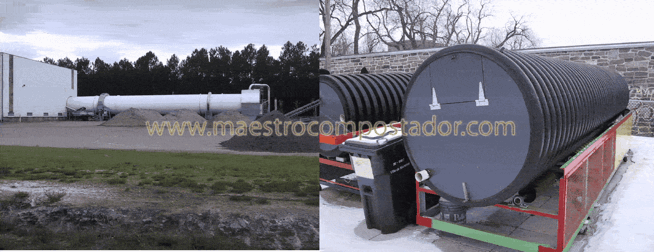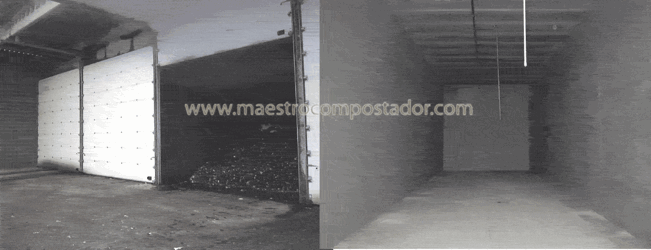Closed Systems
They are characterized because the material is never in direct contact with the exterior, and all the outputs and inputs of gases and liquids are made thanks to a system of conducts and turbines. The most sophisticated and complex composting systems are technologically situated in this category. Its two main advantages respect to the previous methods are the excellent control of emissions to the medium and the affined dominium of the processes' parameters, but also they save site because they present an unbeatable relation between the treated waste volume and the occupied surface. It could be theoretically allowed its installation in the middle of a population if it would be necessary, although it bears an extreme control of the affections of all the rest related operations with the movement and management of materials (reception, mixtures, discharges, maturation...) as well as the knowledge and good practices on management and control of the cleanage elements and emissions depuration.
In general, they are devices levies of several different and varied types, usually denominated reactors, that could be divided into dynamics and static’s for a better understanding.
Composting in dynamic reactors
The most common ones are the cylinders or drums, with a mainly horizontal disposition although there are also vertical ones. The rotation in the horizontal ones or the presence of internal mechanics elements in the vertical ones, allow move the interior material and make it to advance in the reactor, simulating the turn effects.
The first system in drums was the DANO system (1937). Actually, it has ventilation systems, mass temperature probes and reception of gases generated in the interior of the drum for its posterior depuration. DANO system must not be considered by itself as a composting system because of the material remains in the interior of the drum no more than three days, where is homogenised and crumbled, improving the waste physical conditions for its posterior composting in windrows, or in other system, making these more efficient ones. From the initial model of DANO type, other drum systems were evolved.
One of the main advantages of this system is its possibility of graduation depending on necessity, because it could be sized and designed composting drums in a small scale for the treatment of not high organic waste productions, like the productions of a small community or neighbourhood, that they really could not justify the inversion in an industrial facility of treatment.

The horizontal dynamic reactors come being the last step in the evolution from turned windrows to composting in trenchers (Mid-open) and from this to the dynamic drum (closed). Its forms and dimensions are close similar to the static drums or reactors, but with the differentiation that it has mechanical elements that could be fixed in the interior or external and that come in periodically, turn and homogenise the material into compost. They have also a perforated false soil that allows the lixiviate reception and mass ventilation.
In-vessel composting or composting in static tunnels
There are simpler devices for lack of own movement or movement of interior mechanical elements. The most common types are the contenders and the drums, but the third type, the silos, has very low implantation.
The containers are hermetic parallelepiped recipients, generally of steel with anticorrosion treatment, with double soil for ventilation and lixiviate collection, with volumes between 20 and 50 m3. Due to its size and weight they have the interesting advantage that they can be moved from one place to another depending on our own interest, can be filled in the area of the waste production and move them full to the operational area, where they can be connected to the control and ventilation systems. The parameters that are being controlled and the way to do it are close similar to those used in drums and that we next will see, so we will send to the explanations explained there. There are relatively expensive, but their modularity makes them so versatile and tremendously useful for those places where a high variety of different organic wastes are produced in not high amounts.
The composting drums or compo drums is a technology which origin must be looking for in the traditional industry of substrates obtention for mushrooms culture that, after a great practical experience in one very concrete kind of materials was adapting its design to can be applied in composting another kind of organic wastes. The parameters control of the process that could be excellent if the temperature probes and devices gas sensors (so much from the matrix interstitial space in the process, like from the ventilation conducts or the free atmosphere in the upper part of the drum) are enough and well distributed. The gases to be analyzed are the oxygen (almost always) and optionally in some occasions the CO₂, NH₃ or others. Other traits indirectly related with the process as the air pressure in the ventilation plenum, the moisture and temperature of the air used in the material ventilation, the working hours and the electric consume of the fans could also be monitorized. All these measurements are transmitted to a programmable PLC (Programmable Logic Controller) which sends them to a computer provided with a specific control program that controls and rectifies as we want the process by using forced ventilation and watering. The data bank obtained from the computer memory gives a punctual value accumulation of the information and its study for a long time results very useful for the knowledge and improving of the composting process, as well as for diagnostics. The ventilation is realized by a false perforated soil and could be by under pressure, depression (aspired) or by overpressure (blown), being able to recirculate the air of the process. Lixiviates could be collected, conduced to a tank (normally together with the soil pluvial water) and reutilized for the moisturizing of the following lot. No liquids come out from the process to the exterior because it is a closed circuit. The gases that are not recirculated, are conduced to depurator’s bio filters, and there are intermediate possibilities of wash systems (scrubbers), refrigeration and /or watering. The main advantages are the extreme robustness of installations, its poor necessity of space and the control of the environmental affections.
The common retention time is between two and three weeks, time enough to obtain a reasonable stability grade of the waste, but not enough to have the possibility of directly apply the product, so it is normally to need a posterior maturation period, generally in windrows or turned table heaps, although there are installations that have tunnels for the maturation of the output material of the tunnels where the initial decomposition was realized, but in this cases there are no turns of material that influence negatively the quality and maturation of the final compost.



